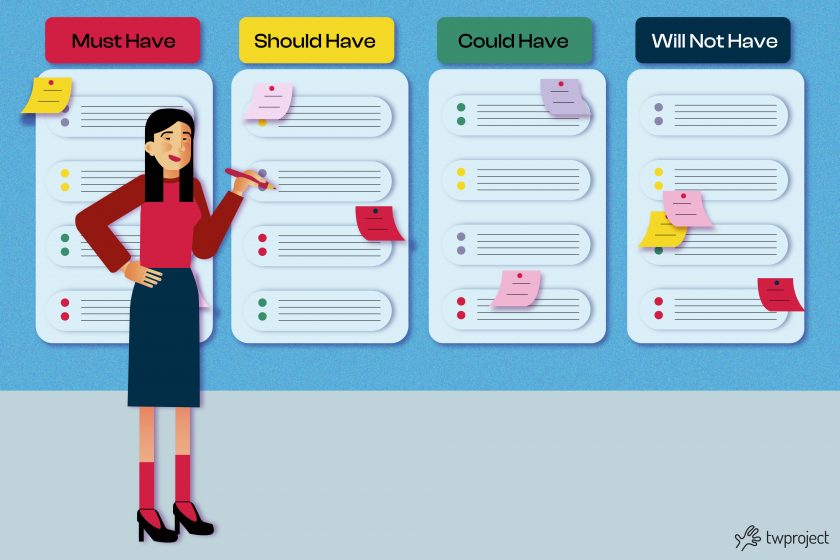The MoSCoW method can be a successful way to get everyone aligned on project priorities.
Collaborating with cross-functional teams and key stakeholders to prioritize effectively is challenging, yet it is a critical step in product development.
In this article, we will explore what the MoSCoW method is and how it helps prioritize activities.
CONTENT
What is the MoSCoW method?
Developed in 1994 by Oracle Dai Clegg, the MoSCoW method is a simple yet powerful solution for prioritizing.
Easy to set up and exceptionally useful for managing projects with limited time or resources, the MoSCoW method helps the development team classify product functionality and features into four key areas:
M = “Must have”
These characteristics must necessarily be implemented to meet basic user expectations or exceed the primary constraints of product safety or reliability.
S = “Should have”
These attributes set a new product apart from competitors’ offerings. Although these features provide clear value to the end user, they are not essential to launching a product and, therefore, are less urgent to implement in the short term.
C = “Could have”
These features can significantly impact a product’s commercial success and should be implemented, although only if the development team has time to work on them without affecting other essential functionality. For example, if a project is running late, these features can be sacrificed in the short term to ensure timely delivery of a less complete product version.
W = “Won’t have”
These are not essential features in the short term and could be addressed in future product iterations. Should product or user needs evolve, these features could easily move up the priority order at any time.
How does the MoSCoW method work?
The MoSCoW method ranks all potential features according to what needs to happen now and what might happen in the future.
Below are the three critical steps in practice:
1. Identify activities to be accomplished
The product team meets to brainstorm all activities related to the successful delivery of a new product. They do not need to prioritize them at this time—the focus at this stage is simply to ensure that all the features researched and activities are identified.
2. Prioritize activities
Having listed all the tasks to be completed, it is time to prioritize them in one of the four categories mentioned above:
- What features are essential to launch a functional and appealing product?
- What features are essential but less urgent at the moment?
- What features can be developed only when time permits?
- What features can be put on hold for now and redefined later?
A consensus must be reached on what is needed to launch a product version that meets users’ primary needs and expectations.
3. Validate the prioritization
It is very easy to identify many activities as essential, particularly when considering the different objectives and priorities of different stakeholders. Still, the goal should always be to get a list of essential activities as concise as possible. This requires complete alignment of the team and all stakeholders.

Pros of MoSCoW method
- Easy to manage: This method is based on elementary and easy-to-understand principles, so you won’t need to do much basic research before getting started.
- It helps set priorities and sort them into a hierarchy. This way, there will never be confusion about which elements are more or less important than others.
- Helpful for group discussions: The MoSCoW method can be an excellent way for team members to open up about their ideas.
- Helps achieve stakeholder consensus: The MoSCoW method can be a sound way to reach an agreement on priorities when used among stakeholders. When stakeholders participate during the categorization process, their understanding of the project is improved.
- Can prevent scope creep: Scope creep occurs when unintended changes occur during project execution. It can be prevented by setting clear and fixed priorities at the beginning.
An example of the MoSCoW method
Let’s consider a startup developing a Web app to help busy employees manage their inboxes more effectively. This new company wants to launch a core product as quickly as possible.
Here is how they might use the MoSCoW method:
Must have
- Automatic e-mail sorting and organization
- Clear search feature
- Built-in calendar to automatically schedule meetings and events based on inbox content
These core features help users easily manage their inboxes and operate the product.
Should have
- Option to manage multiple mailboxes within a single dashboard.
- Postponement and reminder functionality for follow-up e-mails.
- E-mail templates for common scenarios.
These are critical features and should be prioritized, although they are not essential to the product’s functionality.
Could have
- AI e-mail writer or suggestions based on the user’s previous communications.
- Workflow automation rules to automate repetitive e-mail tasks.
- Automated e-mail follow-ups.
These are all nice initiatives to have and could be a priority later, yet they are not necessary or essential for the current release. Users will still get much value from the product without them, and their absence does not affect functionality.
Won’t have
- Talk-to-text functionality for writing and replying to e-mails.
- Offline mode.
- Desktop version (this team is focusing on a Web app first).
None of these features suit the product’s main vision at its current stage, and none of them are currently needed or impact the product’s functionality.
Implementing the MoSCoW method in Twproject
Twproject is a project management software especially suited for task and priority management.
One of Twproject‘s most appreciated features is the option to display tasks and their priorities visually through various visualization tools, such as Gantt charts, Kanban Boards, and to-do lists.
These tools help teams maintain a clear view of deadlines and responsibilities, thus leading to more efficient priority management.
Its user-friendly interface and various features allow prioritization of tasks using highly customizable matrices and templates.
Furthermore, Twproject streamlines sharing tasks and priorities with stakeholders and other team members to ensure everyone’s alignment.




